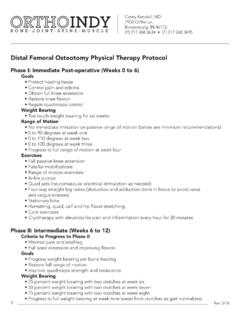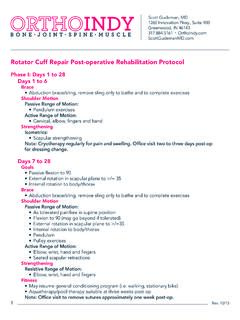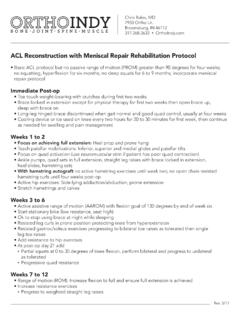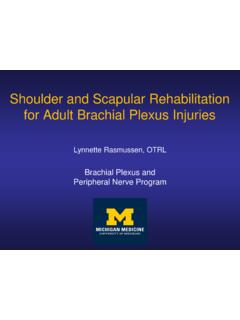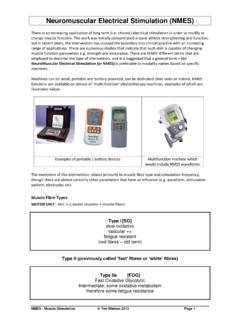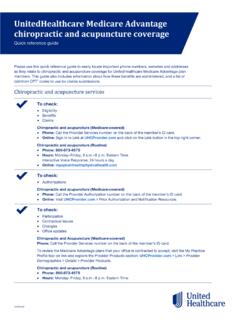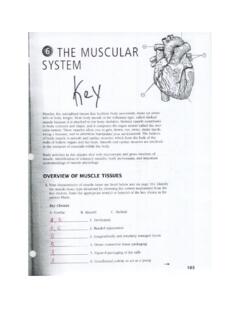Transcription of Medial/Lateral Partial Meniscectomy Post-operative ...
1 Scott Gudeman, MD. 1260 Innovation Pkwy., Suite 100. Greenwood, IN 46143. Medial/Lateral Partial Meniscectomy Post-operative Rehabilitation Protocol Phase I: Day 1 to 2 Weeks Brace Knee immobilizer TED hose to be worn until ambulation has returned to normal pre-surgery level or two weeks Crutches: weight bearing as tolerated Goals Decrease inflammation and swelling Restore knee range of motion (0 to 115 degrees, minimum 0 degrees extension to 90 degrees flexion before Phase II). Re-establish quadriceps muscle activity/re-education Weight bearing as tolerated with use of crutches until normal gait is achieved Note: Return to office for post-op appointment at day one or two for dressing change and at one week post-op for suture removal.
2 Knee Motion Passive Range of Motion: Prone hang or heel prop (with or without ice). Active Range of Motion: Ankle pumps Quadriceps sets Straigh leg raises Hip abduction, adduction, extension Gluteal sets Heel slides Stationary bike (no resistance, for range of motion only). Strengthening: Partial squats (complete with supervision of physical therapist or certified athletic trainer). Stretching: Active assistive range of motion stretching (quadriceps, gastroc, soleus and hamstring). Modalities neuromuscular electrical stimulation if patient has quadriceps shut down. Thirty minutes, two times a day, seven days a week. Phase II: Weeks 2 to 8. Brace None Goals Restore and improve muscular strength and endurance Gradual return to functional activities Restore normal gait Improve balance and proprioception Re-establish full, pain free range of motion.
3 1 Rev. 12/15. Week two, 0 to 125 degrees Week three, 0 to 135 degrees Week four, 0 to 145 degrees Cardiovascular Stairmaster, elliptical, treadmill (no running) and bike Aquatic therapy: running in pool or on AlterG Anti-Gravity Treadmill four to six weeks (incision needs to be fully closed). Knee Motion Passive Range of Motion: Continue all from Phase I. Active Range of Motion: Continue all from Phase I. Strengthening: Toe raises and calf raises Hamstring curls Lunges front and lateral Leg press (not past 90 degrees). Step-up, step down, lateral step-up Four way hip: standing Knee extension exercise: 90 to 40 degrees (do not use machine). TKE. Closed kinetic chain Stretching: Continue all from Phase I.
4 Proprioception Proprioceptive and balance training Modalities neuromuscular electrical stimulation if patient has quadriceps shut down. Thirty minutes, two times a day, seven days a week. Phase III: 8 Weeks +. Goals Enhance muscular strength and endurance Maintain full range of motion Knee Motion Functional: Begin Begin plyometrics/vertical jumps Initiate running program Agility drills progression Forward/backwards running, cutting, figure eight and carioca Sports specific drills/activities (begin with non-contact). Note: Monitor patellofemoral joint pain and avoid activities that may aggravate it. Helping you achieve the optimal activity level for your lifestyle Scan here to visit is my first priority.
5 - Scott Gudeman, MD. 2.
